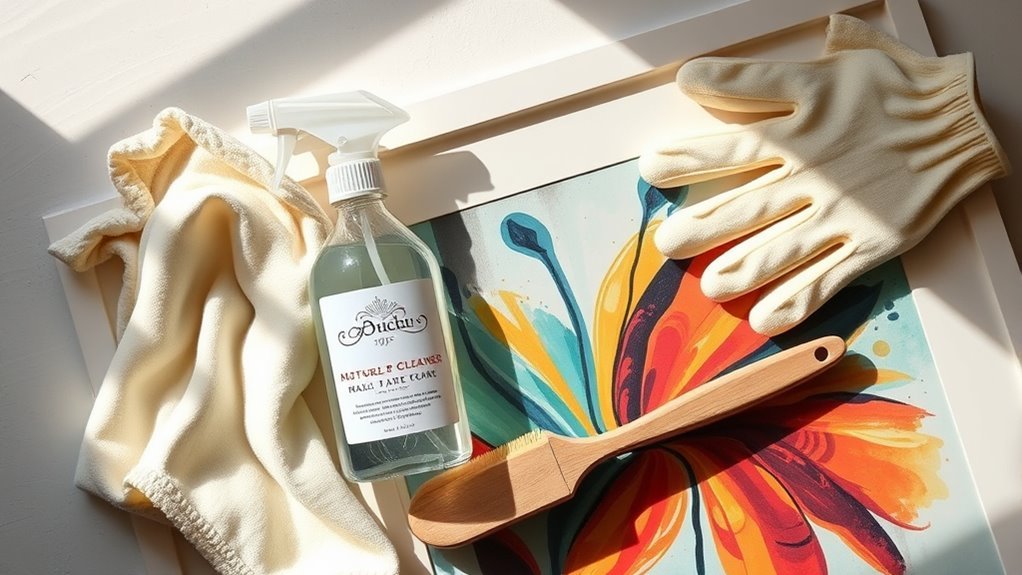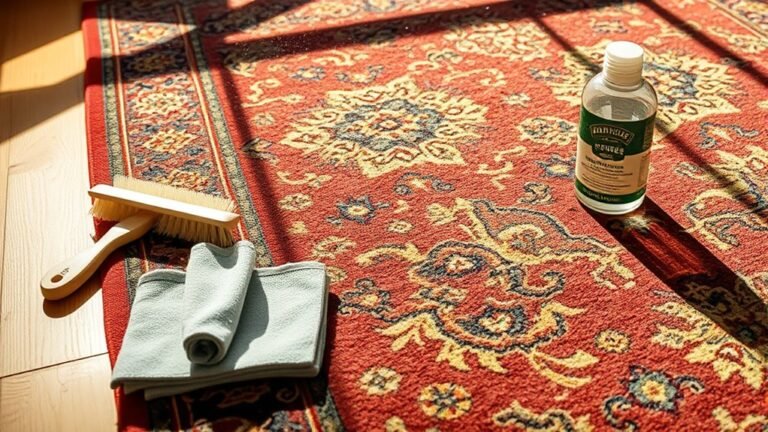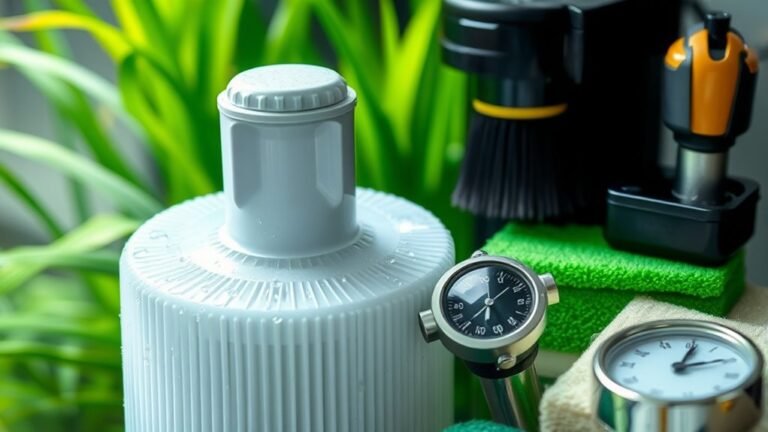Tips for Cleaning and Maintaining Wall Art
To keep your wall art looking fresh, dust gently with a soft microfiber cloth or natural brush, avoiding sprays directly on the piece. Different materials like canvas, metal, or wood need specific care—canvas dusts easily, metal wipes softly, and wood stays polished. Control sunlight and humidity to prevent fading or warping. Always handle art with clean gloves and store it in stable conditions. Following these tips helps protect your investment, and there’s more to discover about preserving your artwork’s beauty.
Understanding Different Types of Wall Art Materials
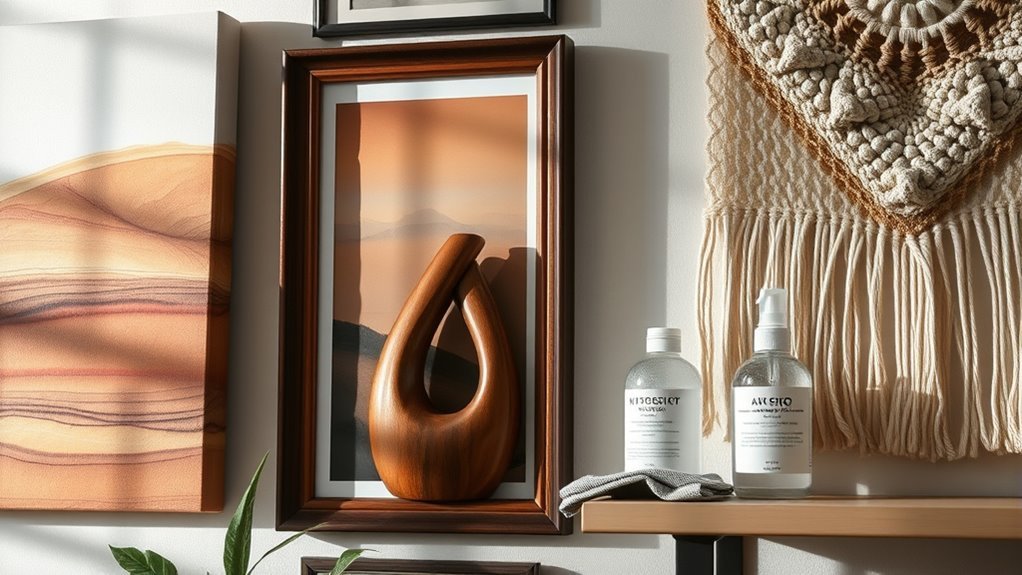
When it comes to cleaning and maintaining wall art, knowing the materials involved is key. You’ll find that canvas prints demand gentle dusting, as harsh treatments can damage their delicate surfaces. Metal art, on the other hand, often requires wiping with a soft cloth to avoid scratches and prevent rust. Wood sculptures are sensitive to moisture, so you’ll want to keep them dry and occasionally polish them to preserve their natural luster. Textile pieces call for extra care—vacuuming lightly or using a lint roller helps keep dust at bay without harming the fibers. Mixed media artworks combine various elements, so you need to assess each component individually before cleaning. Understanding these distinctions gives you the freedom to care for your art confidently and effectively.
Essential Tools for Cleaning Wall Art
Knowing the materials your wall art is made of helps you choose the right cleaning tools. To keep your pieces looking fresh, gather essential cleaning supplies like soft microfiber cloths, gentle brushes, and pH-neutral cleaning solutions. Avoid harsh chemicals that could damage delicate surfaces. Maintenance tools such as cotton gloves protect your artwork from oils and dirt on your hands, giving you freedom to handle your pieces safely. Depending on your art’s medium—canvas, glass, metal, or wood—you might also need specialized tools like compressed air or soft sponges. Having the right cleaning supplies and maintenance tools guarantees you can care for your wall art confidently, preserving its beauty without restrictions or risk. Choose tools that respect your artwork’s uniqueness and your desire for effortless upkeep.
How to Safely Dust Your Artwork
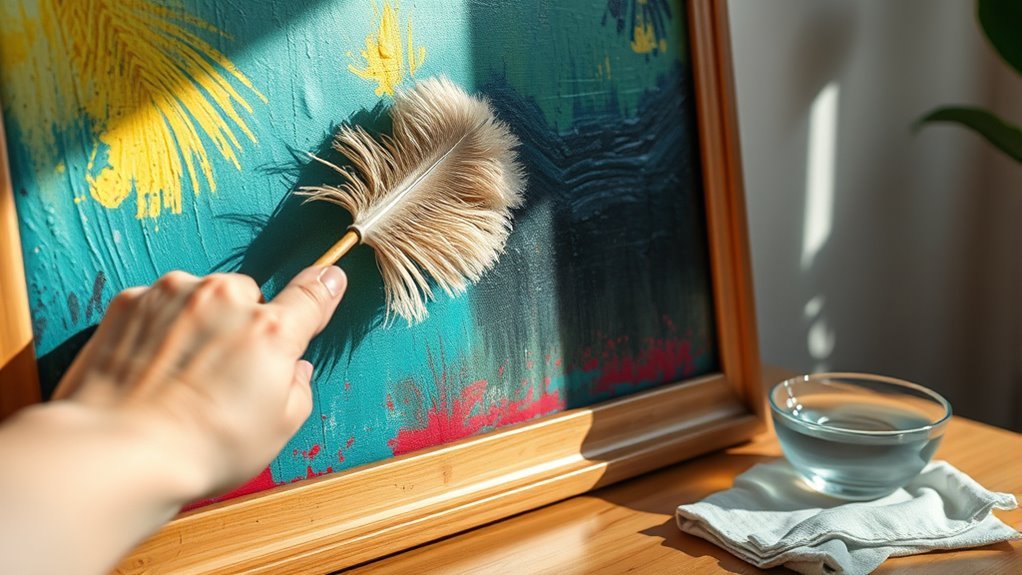
Although dusting might seem straightforward, it’s important to approach your artwork with care to prevent damage. Using the right dusting techniques guarantees your pieces stay vibrant without risking their integrity. Avoid harsh cleaning solutions that could erode delicate surfaces. Instead, keep it simple and gentle.
Proper dusting preserves your artwork’s vibrancy—use gentle techniques and avoid harsh cleaners to protect delicate surfaces.
Here’s how you can safely dust your artwork:
- Use a soft, dry microfiber cloth or a natural bristle brush to lift dust gently.
- Work in one direction to avoid rubbing particles into the surface.
- Avoid spraying any cleaning solutions directly onto the artwork; if needed, apply lightly to your cloth.
Techniques for Cleaning Glass and Frames
Three simple steps can help you keep the glass and frames of your artwork spotless without causing damage. First, for effective glass care, use a soft, lint-free cloth with a gentle glass cleaner or a mix of water and vinegar. Spray the cleaner on the cloth, never directly on the glass, to avoid drips that can seep into the frame. Next, for frame maintenance, dust regularly with a dry microfiber cloth. For wooden frames, occasionally apply a small amount of wood polish to preserve their finish and prevent drying or cracking. Finally, avoid harsh chemicals or abrasive tools on both glass and frames to maintain their integrity. With these techniques, you’ll enjoy clear views and lasting beauty in your wall art.
Protecting Wall Art From Sunlight and Humidity
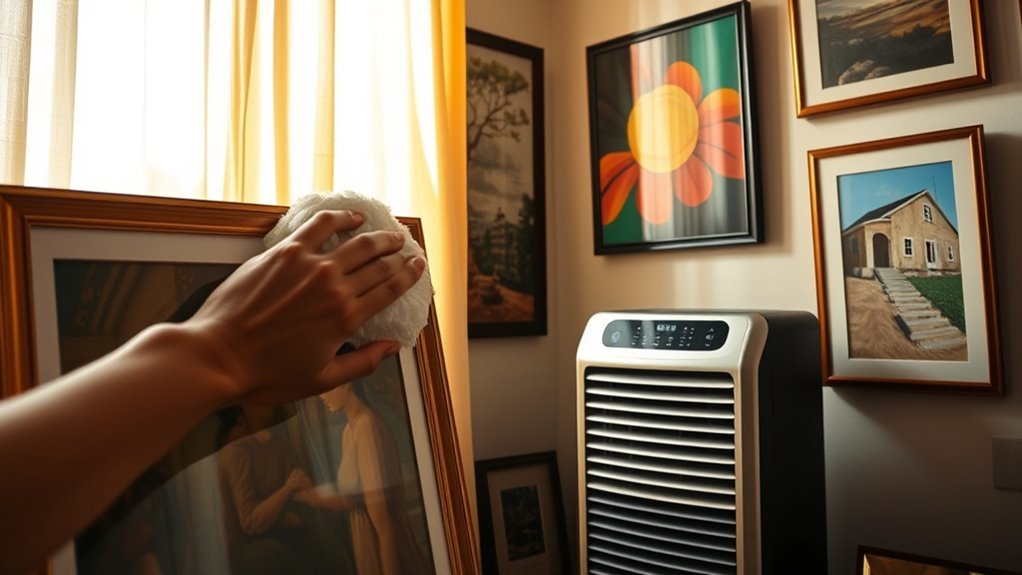
To keep your wall art looking its best, you’ll want to minimize its exposure to direct sunlight, which can cause fading. Controlling indoor humidity is also key to preventing damage like warping or mold. You might consider applying protective coatings to add an extra layer of defense against these elements.
Minimizing Sunlight Exposure
When you want to preserve your wall art’s colors and materials, minimizing sunlight exposure is essential. Direct sunlight can fade pigments and weaken textures, so controlling how much light reaches your pieces lets them stay vibrant longer. You can freely enjoy your art without worry by using practical solutions like:
- Installing sunlight filters that reduce UV rays without darkening your space
- Choosing window treatments such as blinds or curtains to block harsh midday sun
- Positioning artwork away from windows or in shaded areas where natural light is indirect
Controlling Indoor Humidity
Beyond managing sunlight, keeping indoor humidity in check plays a big role in protecting your wall art. When moisture levels fluctuate wildly, materials like canvas, paper, and wood can warp, crack, or even develop mold. You’ll want to maintain consistent humidity control, ideally between 40-60%, to preserve your pieces without compromising your space’s comfort. Using a dehumidifier or humidifier helps regulate moisture levels effectively. Plus, good ventilation keeps the air fresh and prevents dampness buildup. By taking charge of humidity control, you’re not just safeguarding your art—you’re creating an environment that lets your creativity and freedom flourish without worry. Remember, steady moisture levels are key to keeping your wall art vibrant and intact for years to come.
Using Protective Coatings
Although controlling light and humidity is essential, applying protective coatings adds another layer of defense for your wall art. You can choose from various coating options designed to shield your artwork from sun damage and moisture exposure without compromising its look. Protective sprays are a popular choice because they’re easy to apply and offer a clear, durable finish. Consider these options to keep your art vibrant and intact:
- UV-resistant sprays to block harmful sunlight and prevent fading
- Water-repellent coatings that protect against humidity and accidental splashes
- Anti-dust sprays that reduce buildup and simplify cleaning
Handling and Storing Wall Art Properly
When you handle wall art, it’s important to use proper techniques to avoid damage, like wearing gloves and supporting the piece securely. Storing your artwork in a cool, dry place with stable humidity helps keep it in good condition. You should also protect the surfaces by using acid-free materials and avoiding direct contact with harsh elements.
Proper Handling Techniques
Handling and storing wall art properly starts with understanding the materials and fragility of each piece. Whether it’s a delicate canvas or a framed print, you’ll want to treat every artwork with care, especially during artwork transportation. Use proper framing techniques to add protection and stability, making handling safer and easier. When moving or storing your art, remember to:
- Always wear clean gloves to avoid oils from your hands transferring to the surface.
- Support the art from underneath, never by the frame edges alone.
- Wrap pieces in acid-free paper or bubble wrap to prevent scratches and dents.
Ideal Storage Conditions
Since wall art is often sensitive to environmental changes, you’ll want to store it in a stable, controlled space to prevent damage. Maintaining the ideal temperature—typically between 65°F and 75°F—helps keep your pieces in prime condition. Alongside that, suitable humidity levels between 40% and 50% prevent warping, mold, or cracking. Avoid extreme fluctuations, as they can stress materials and shorten your art’s lifespan. Choose a location away from direct sunlight, heat sources, or damp areas, so your artwork isn’t exposed to harmful elements. When you store your art properly, you’re giving yourself the freedom to enjoy it for years without worry. Keeping these conditions in mind guarantees your wall art stays vibrant and intact, ready to inspire whenever you want.
Protecting Artwork Surfaces
Properly storing your wall art is just one part of keeping it safe—how you handle and protect its surface is equally important. To guarantee your art stays pristine, always handle it with clean, dry hands or wear cotton gloves. Avoid touching the surface directly to prevent oils or dirt from damaging the piece.
Here are some key tips to protect your artwork’s surface:
- Use acid-free materials for wrapping or covering to prevent chemical damage.
- Keep artworks away from direct sunlight and humidity to avoid fading and warping.
- Invest in artwork insurance for peace of mind in case restoration services become necessary.
When to Seek Professional Cleaning Services
How do you know when it’s time to call in a professional for cleaning your wall art? If your piece is valuable, delicate, or the dirt is stubborn, professional services are your best bet. Also, if you’re unsure about the cleaning frequency or methods, experts can help preserve your art’s freedom to shine.
| Situation | Action Needed |
|---|---|
| Stains or grime buildup | Call professional services |
| Fragile or antique artwork | Avoid DIY, seek experts |
| Uncertain cleaning frequency | Consult professionals |
| Persistent discoloration | Professional cleaning |
Trusting pros prevents damage and extends your art’s life, giving you peace of mind and freedom from worry.
Frequently Asked Questions
Can Wall Art Be Cleaned With Household Cleaning Sprays?
You shouldn’t use regular household cleaning products on your wall art because they might damage it. Instead, opt for gentle methods that support artwork preservation, like dusting with a soft cloth or using specialized cleaners designed for art. Keeping your artwork safe means you get to enjoy its beauty freely without worry. So, skip harsh sprays and choose care that respects your piece’s longevity and your creative freedom.
How Often Should I Clean My Wall Art?
Think of your wall art like a garden—it needs regular care to keep thriving. Your cleaning frequency should depend on where it’s displayed; dust every 2-4 weeks to prevent buildup and protect your investment. Too much cleaning can harm delicate pieces, so gentle dusting is key for art preservation. This balance lets your artwork breathe and stay vibrant, giving you the freedom to enjoy its beauty without worry.
Are There Specific Cleaning Methods for Outdoor Wall Art?
When you’re cleaning outdoor wall art, you’ve got to take into account the outdoor materials it’s made from, like metal, wood, or stone. Each needs a different approach—gentle wiping for wood, maybe a soft brush for stone. Don’t forget protective coatings; they help shield your art from weather damage. You’ll want to avoid harsh chemicals that could strip those coatings. Keeping it simple lets you enjoy your art freely without worrying about damage.
Can Cleaning Wall Art Improve Its Value?
Yes, cleaning your wall art can boost its value, especially if done with care focused on art preservation. When you remove dust and grime without damaging the piece, you help maintain its original condition, which collectors love. This careful upkeep can lead to value appreciation over time. Just make sure you use the right methods to keep your art looking fresh and vibrant, so it stays a source of pride and freedom in your space.
Is It Safe to Use Gloves When Cleaning Artwork?
It’s definitely safe to use gloves when cleaning artwork, as long as you pick the right glove materials. Cotton gloves are popular because they prevent oils from your skin transferring onto the piece, while nitrile gloves offer protection without leaving lint behind. Just remember, your cleaning techniques should be gentle—avoid harsh scrubbing or chemicals. Using gloves helps you maintain freedom to handle art carefully without risking damage.
